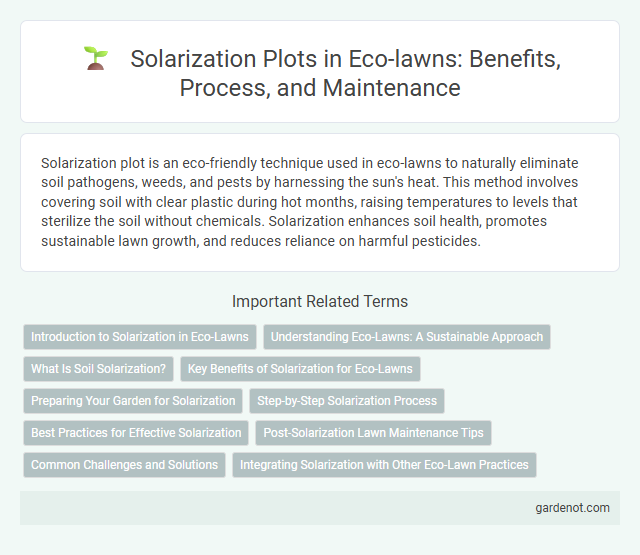Solarization plot is an eco-friendly technique used in eco-lawns to naturally eliminate soil pathogens, weeds, and pests by harnessing the sun's heat. This method involves covering soil with clear plastic during hot months, raising temperatures to levels that sterilize the soil without chemicals. Solarization enhances soil health, promotes sustainable lawn growth, and reduces reliance on harmful pesticides.
Introduction to Solarization in Eco-Lawns
Solarization in eco-lawns uses solar energy to naturally heat the soil, suppressing weeds and soil-borne pathogens without chemicals. This sustainable method enhances soil health by promoting beneficial microbial activity and improving nutrient availability. Effective solarization typically requires sustained sunlight exposure of 4 to 6 weeks under transparent plastic sheeting, optimizing weed control and soil sterilization.
Understanding Eco-Lawns: A Sustainable Approach
Solarization plot techniques enhance eco-lawn sustainability by using solar energy to reduce soil pathogens and weed seeds naturally. This environmental method improves soil health without chemical herbicides, promoting resilient, low-maintenance grass species adapted to local climates. Adopting solarization in eco-lawn management supports biodiversity, conserves water, and reduces carbon footprints, aligning with green landscaping practices.
What Is Soil Solarization?
Soil solarization is an eco-friendly agricultural technique that uses clear plastic sheets to cover and heat the soil through solar radiation, effectively controlling soil-borne pests, weeds, and pathogens. This method raises soil temperatures to levels that disrupt the life cycles of harmful organisms without chemical interventions. Prominently used in eco-lawn maintenance, soil solarization enhances soil health and promotes sustainable weed management.
Key Benefits of Solarization for Eco-Lawns
Solarization significantly improves eco-lawns by naturally eradicating weeds, pests, and soil-borne diseases through solar heat, reducing reliance on chemical herbicides and pesticides. This sustainable method enhances soil fertility by accelerating organic matter decomposition and promoting beneficial microbial activity, leading to healthier grass growth. It also conserves water by improving soil structure and moisture retention, making eco-lawns more drought-resistant and environmentally friendly.
Preparing Your Garden for Solarization
Preparing your garden for solarization involves clearing the plot of existing vegetation and debris to maximize sun exposure and soil heating. Moistening the soil deeply before covering it with clear plastic enhances heat retention and promotes the elimination of weeds, pests, and soil pathogens. Ensuring soil is level and compacted helps maintain consistent contact with the plastic, improving the effectiveness of the solarization process.
Step-by-Step Solarization Process
The solarization process for eco-lawn preparation involves covering the soil with clear plastic sheeting, typically for 4 to 6 weeks during the hottest months to trap solar energy and elevate soil temperatures. This method effectively eliminates weed seeds, pests, and soil-borne diseases without chemicals, promoting healthier turfgrass growth. Proper soil moisture before covering enhances heat penetration, and secure plastic edges prevent heat loss, making solarization a sustainable step in eco-lawn establishment.
Best Practices for Effective Solarization
Solarization plot best practices include using clear polyethylene tarps to trap solar heat and maintaining soil moisture for enhanced heat transfer, targeting temperatures above 45degC (113degF) for 4 to 6 weeks to effectively eliminate weeds, pests, and pathogens. Monitoring soil temperature at multiple depths ensures optimal thermal exposure, while timing solarization during the hottest months maximizes results. Proper soil preparation, including tilling and smoothing, improves tarp contact and heat penetration, increasing the solarization's efficacy in eco-lawn management.
Post-Solarization Lawn Maintenance Tips
Post-solarization lawn maintenance involves watering the soil deeply to promote healthy root growth after heat treatment eliminates pests and weeds. Implementing organic compost applications enhances soil nutrients and supports beneficial microbial activity critical for eco-friendly turf establishment. Regular mowing at a higher blade height encourages dense grass growth, reducing weed resurgence and improving overall lawn resilience.
Common Challenges and Solutions
Solarization plots often face challenges such as soil moisture inconsistency, pest resistance, and uneven heat distribution, which can limit the effectiveness of weed and pathogen control. Maintaining optimal soil temperature between 110degF and 125degF for 4-6 weeks is critical to ensure successful solarization in eco-lawn establishments. Solutions include using transparent polyethylene mulch, scheduling solarization during peak sun months, and implementing soil moisture management techniques to maximize heat penetration and pathogen eradication.
Integrating Solarization with Other Eco-Lawn Practices
Solarization enhances eco-lawn health by using solar heat to naturally reduce soil pathogens and weed seeds, improving soil conditions for sustainable grass growth. Integrating solarization with organic mulching and compost application boosts soil fertility and moisture retention, promoting robust turf development. Combining these methods supports eco-friendly lawn management by minimizing chemical inputs and fostering resilient, drought-tolerant grass species.
Solarization plot Infographic

 gardenot.com
gardenot.com